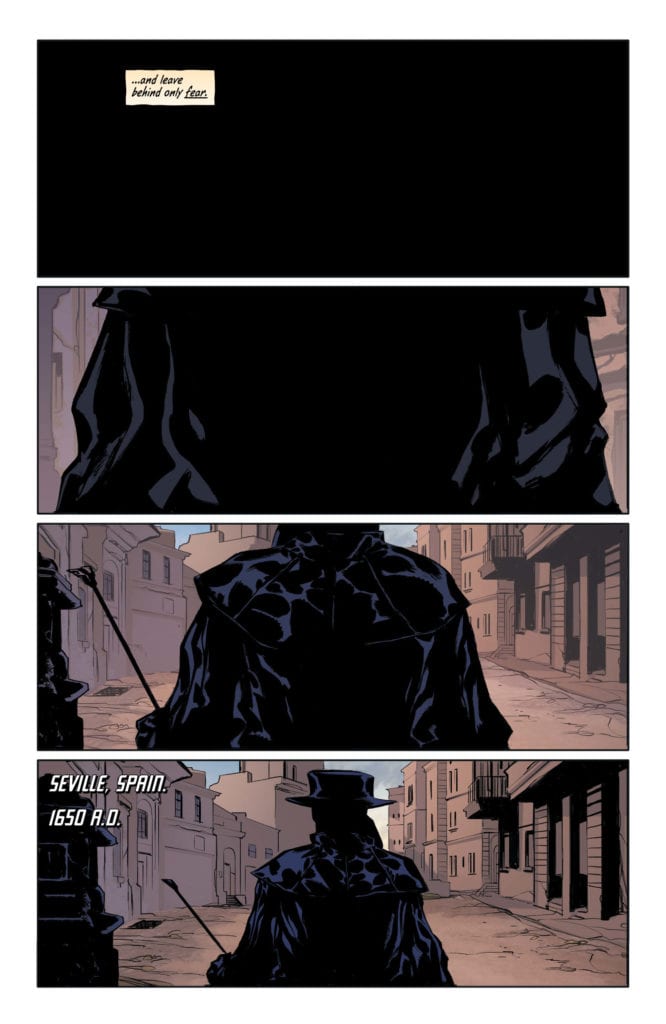Written by Robert Venditti, with art by Marcio Takara, Fernando Pasarin and Oclair Albert, colors by Jeromy Cox and lettering by Rob Leigh, DC Comics’ Hawkman #23 takes a break from the main plot to remind us of what we are in control of in trying times. Whether the creative team at DC Comics added this story break recently, or whether it’s just coincidence, the story couldn’t come at a better time. We can’t control everything, this story tells us, but how we act with what we can handle matters most.

Writing
Venditti introduces us to Carlo Salon, Hawkman’s lifetime during the Black Death. As a plague doctor, Hawkman goes from house to house, taking note of the deaths at each place. It’s a quiet issue. There isn’t a ton of dialogue, and Venditti’s writing actually kind of mimics the feel of a town on lockdown. In fact, the whole issue feels like a twisted reflection of our current state of affairs. But it also reminds us of a couple of things. First, things could be worse. And second, fear can make us do things that are far worse than what a plague can do. Venditti doesn’t pull his punches in making his point. He drives the point home overtly, with characters saying exactly what he’s getting at. It gives this issue a kind of “call to action.” Even if that action is just staying at home and looking out for your fellow man.
Art
Takara, Pasarin, and Albert switch art styles when we begin following Carlo Salon. These scenes in 1650’s Spain aren’t quite as anatomical as other chapters in the series. It lends warmth to each moment. The slightly more stylized outlines and details of the characters allow it all to feel more like a memory being sketched back out again. Yet the shadowy ambiance, which adds to the less detailed approach, give each moment a feeling of closeness and intimacy. It’s as though we see a profoundly personal dream from Hawkman’s mind. Our return to the present day, with the return of the old style of art, feels just like waking from a dream as well. The stylized gives way to realism.

Coloring
Cox’s colors in this issue never let us forget what is going on for these characters. Nearly every page, once our setting has been established, is haunted by a tinge of red. Whether it’s the overt redness of a rose picked by Hawkman or the red glow of a sunset. Cox is reminding us that death is ever-present in these panels. It is always on the mind of these people, and so it’s continuously presented before our eyes. Yet the red evolves too. The red comes to signify the anger, born of fear, in the populace. Their red rage takes over. Only once the mobs have dissipated do the red torches and sunsets give way to a bright yellow sunrise. Cox ends Carlo Salon’s story by giving us something to hope for.
Lettering
Leigh imbues Hawkman with empathy in his lettering. While many of the townsfolk are scapegoating Carlo Salon in hurried speeches, Salon responds in measured dialogue. Not only are his responses parsed out into different speech bubbles, but a lot of air is allowed in between them. The mob brings their accusations against him in large chunks of text. But Salon’s response is often brief. When it isn’t, it’s followed by a space between each bubble. He is not reacting in fear but trying to have empathy for a clearly fearful group of people. We get the sense Salon is choosing his words carefully, not letting panic get ahold of him.
This creative team has empathetically tackled the idea of pandemics. Venditti asks us to take a look at ourselves and say, “What can I control in this time?” If the answer is just you, that’s good enough. This issue takes time out of the plot to tell us this side story. While a nice break from the main plot in most series is often welcome, this break in the plot feels particularly right. Hawkman #23 is out from DC Comics this week.

